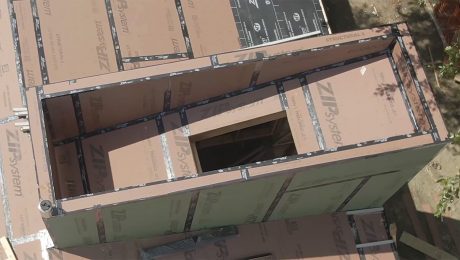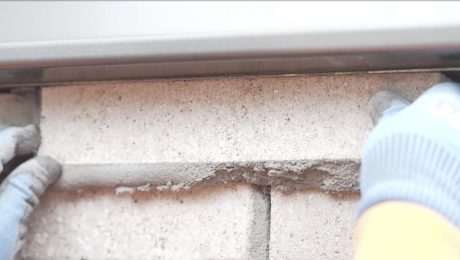Flashing a Window Using ZIP Tape
Travis and Joe walk through the step-by-step process of prepping, caulking, and flashing a window using stretch tape and flashing tape from ZIP System.
Before setting the windows at the Fine Homebuilding House Kansas, we’re prepping the window openings using two different Huber ZIP System products to flash the openings: ZIP System Stretch Tape and ZIP System Flashing Tape.
Apply the stretch tape to the sill
First, I’ll start with the ZIP System Stretch Tape on the sills. Just as the name says, the tape stretches, and it allows us to have a continuous seal on our sill, which helps with both air and water management. The split back means you can peel this tape off in two different segments, making for an easier installation.
Once you peel the first section and press it into the sill, remove the backing from the second section of the tape and start slowly working it into the corners for a durable water-seal at this most vulnerable part of a window opening.
Next, we roll the tape to get the bubbles and the wrinkles out, starting with the corners. You can even see after you’ve rolled that the bond between the tape and the board sheathing is strong. After it’s rolled, it’s hard to pull off.
Apply the flashing tape
Then we use the ZIP System Flashing Tape to connect the air barrier—the green the face of the ZIP System sheathing—into the window opening. It serves dual purposes in this case: as an air-seal and better protection for the window opening, and as protection for the exposed foam edge of the ZIP-R sheathing. Just as before, we roll it out and then complete the process on the other side.
For the top, a small cut in the flashing tape in the corner allows the tape to fold in. A couple little cuts of tape ensure the air-seal.
The Huber roller has Zs embedded in it that leave imprints on the tape, so while I’m walking around the job, I can verify that every window opening has been rolled and that we’re ready to go to the next step.
Caulk the opening
The next step is to caulk the opening, but since this is a flanged window, we apply a continuous, generous bead of caulk from the bottom all the way up, around the top, and down the other side. This creates a seal that the window flanges will mate up against. When we use our fasteners through the flange, that sealant will smoosh down to create an additional air-seal. We don’t seal the bottoms of windows—if there ever is a leak, we want it to drain out—so we’ll do our air-sealing on the inside of the window on the interior side instead.
Flash the window
Once the window has been installed plumb and square and all the operations have been checked, it’s time to apply the flashing tape. We tape the sides first, lapping from the green-coated ZIP panel across the window installation fin and onto the edge of the window frame itself. By lapping over that, we add a level of protection at the weakest point, which is that top corner.
After taping both sides of the window, we go over the top with another section of tape that will actually extend out past the sides. So just like shingle lapping, if you lap one piece over the other, you eliminate the risk of water getting into the system.
As a rule, we’re using the vapor-open tape on all our windows, which gives us a little bit of an additional measure of protection. In case any moisture does get into the assembly, a vapor-open tape allows that water vapor to evaporate and move through the tape to the exterior.
Because we don’t tape that bottom edge of the window on the exterior, air can get in, so we need continuity of air control all the way around the window at the interior. To seal the inside of the windows on most of our builds, we use a backer rod and caulking approach.
RELATED STORIES















































